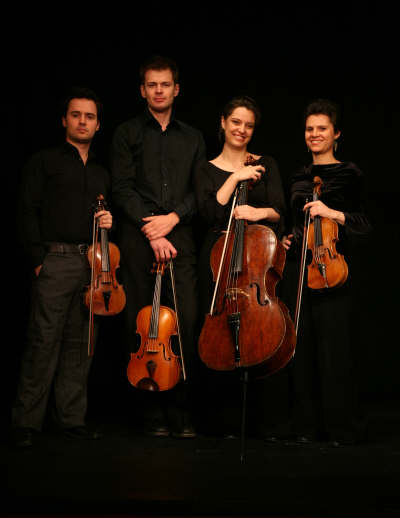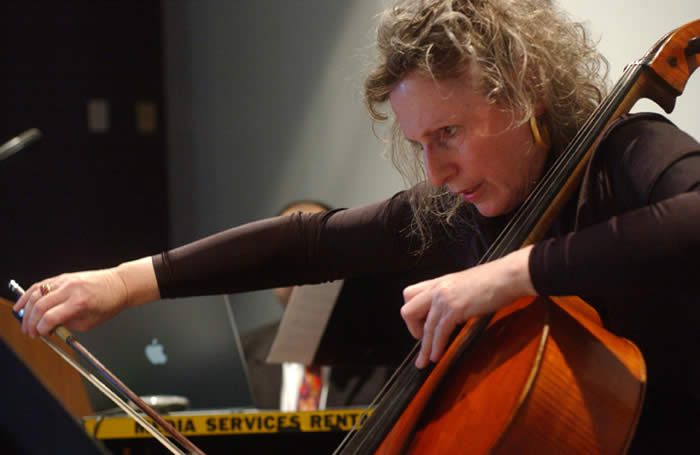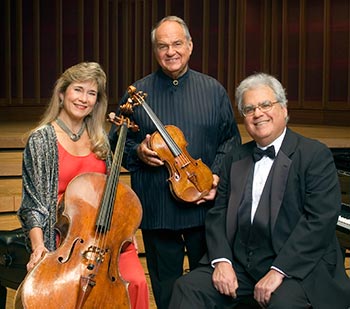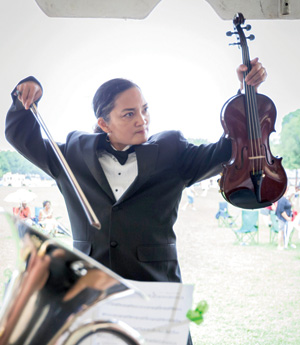Sonic Escape at Evermay Estate
By Stephen Brookes • The Washington Post • March 16, 2014
There may be few concert venues in town as civilized as the Evermay Estate in Georgetown, where you’re greeted at the door by the hosts, offered wine and hors d’oeuvres, and generally invited to make yourself at home. But the real pleasure comes from the young virtuosos showcased in Evermay’s ongoing “Overtures” series, which on Friday night featured the flute-violin-cello trio Sonic Escape in an program that wove together folk and classical music with a light and engaging touch.
It was an evening designed to entertain — one of Haydn’s helium-filled “London” trios was about the weightiest thing on the program — and it did so with a wide-ranging, anything-goes sense of fun. Japanese folk music segued into traditional Scandinavian tunes, Bach melodies were cheerfully fused with Irish gigs, and a funny Canadian waltz got the audience clapping along — all of it tied together with running commentary by flutist Shawn Wyckoff and violinist Maria Kaneko Millar.
It all made for a personable and smile-inducing concert, with fine playing from Wyckoff, Millar and cellist Nan-Cheng Chen. The most interesting music of the evening, though, was not the traditional folk arrangements, but two wonderfully imaginative works by Millar herself. “Mosquito Blue” vividly (and humorously) evoked human’s eternal war with mosquitoes, but it was “Walking the Woods in Twilight” that stole the show. A tribute to the slaves who escaped along the Underground Railroad, it opens in the peace and luminous colors of a summer evening, then builds steadily in tension and rising fear until its final release into freedom. An impressive work from a young composer worth keeping an eye on.
The Elias Quartet at the Library of Congress
By Stephen Brookes • The Washington Post • March 9, 2014
If, like any sensible person, you love the string quartets of Joseph Haydn with a passion beyond all reason, you would have done well to be at the Library of Congress on Friday night. The Elias Quartet — a youngish, much-admired outfit out of Britain — was in town, and opened its rather spectacular recital with the Quartet in F major, Op. 77, No. 2: the last (and maybe the greatest) quartet Haydn wrote.
 The Elias players don’t have a particularly rich sound — the word “astringent” comes to mind — but they make up for it with deft phrasing, a fine sense of dramatic pacing and seamless ensemble work. But even more impressive was the interpretive complexity they brought to the Haydn, a perfectly balanced mix of vitality, depth, formal elegance and that playful, flirtatious wit that makes all of Haydn’s quartets so impossible to resist.
The Elias players don’t have a particularly rich sound — the word “astringent” comes to mind — but they make up for it with deft phrasing, a fine sense of dramatic pacing and seamless ensemble work. But even more impressive was the interpretive complexity they brought to the Haydn, a perfectly balanced mix of vitality, depth, formal elegance and that playful, flirtatious wit that makes all of Haydn’s quartets so impossible to resist.
There’s not a lot of flirtatious wit in Gyorgy Kurtag’s “Officium breve in memoriam Andreae Szervánszky, Op. 28.” It’s better described as a “voiceless requiem in 15 parts” (as lead violinist Sarah Bitloch put it), and it’s steeped in almost unbearable sorrow. But it’s a delicately beautiful work as well, whose concise, resonant fragments blossom into perfect little haikus of sound, as if the mysteries of the universe were being whispered into your ears. The Elias players turned in a subtle, intricately detailed reading.
The evening closed with Beethoven’s Quartet in E minor, Op. 59, No. 2, one of the great “Razumovsky” quartets. The Elias players’ rather bright sound — which served them so well in the Haydn and Kurtag — may have been a slight drawback here, but it was a bold, often thrilling performance nonetheless, from the cosmic meditations of the “Molto Adagio” (which Beethoven said he wrote after “contemplating the harmony of the spheres”) to the galloping “Presto” that closes the work. But some of the most purely enchanting music of the evening came in the encore, a Scottish “Lament for Mulroy” by Donald Grant, the ensemble’s second violinist.
New Music from Anatolia at the Freer Gallery
By Stephen Brookes • The Washington Post • March 7, 2014
For millennia, Anatolia (also known as Asia Minor) has been a cultural crossroads, where the arts of East and West met and transformed each other. That kind of cross-fertilization continues, and — as an intriguing concert at the Freer Gallery of Art on Thursday night demonstrated — is producing music that fuses hard-edged modernism with the deep currents of Turkish and Persian musical traditions. Madeleine ShapiroThe evening included a range of performers, from Kazem Davoudian (a virtuoso on the santur, a 72-string hammered dulcimer) to the cutting-edge ModernWorks Ensemble. Davoudian provided the most vivid links to tradition, performing two lengthy, impassioned improvisations built on the modes of Persian classical music. Both were sweeping tapestries of sound that evoked landscapes of windswept plains, rolling caravans, frenzied tribal dances and the smoke of wood fires.
Madeleine ShapiroThe evening included a range of performers, from Kazem Davoudian (a virtuoso on the santur, a 72-string hammered dulcimer) to the cutting-edge ModernWorks Ensemble. Davoudian provided the most vivid links to tradition, performing two lengthy, impassioned improvisations built on the modes of Persian classical music. Both were sweeping tapestries of sound that evoked landscapes of windswept plains, rolling caravans, frenzied tribal dances and the smoke of wood fires.
The focus of the evening was “Asumani,” a 2012 work for flute and cello by the gifted Turkish-American composer Kamran Ince. It builds spare, questioning music gestures — flavored with microtones and other “extended” instrumental techniques — into a radiant climax before dissolving again into silence. The playful “Lines” (an earlier work for clarinet and piano) showed Ince’s more approachable side, although clarinetist Jo-Ann Sternberg turned in a restrained, low-key performance that never quite took off.
Dancer and choreographer Nejla Yatkin provided a brief dance interlude with her muscular but fluid “What dreams may come . . .” in a world premiere, and cellist Madeleine Shapiro turned in a superb reading of Tolga Tuzun’s “Five Preludes” for solo cello, conjuring up an array of exotic sounds that held together with conviction and purpose.
A set of six “Folk Songs” by the Iranian-born Reza Vali most effortlessly unified tradition with modernism. Vali’s sonic imagination is both sophisticated and vivid — his pairing of a bass flute against high harmonics on the cello was only one of many memorable moments — but there’s a simplicity and directness of expression at the core of his music that made these songs not just interesting but moving. More of Vali’s music is being featured at the Freer on Saturday night.
Kalichstein-Laredo-Robinson Trio at the Terrace Theater
By Stephen Brookes • The Washington Post • March 1, 2014
Can we just be done with it, and declare the Kalichstein-Laredo-Robinson Trio the greatest piano trio on the face of the earth? Sure, there are other worthy groups out there. But as they showed on Thursday night at the Terrace Theater, the KLR players — together now for an astonishing 37 years — have outpaced the competition in everything from effortless virtuosity to striking originality, and perhaps most of all in the intimate democracy of their ensemble work. The thinking person’s piano trio, in every way.  Take, for instance, their impeccable reading of Beethoven’s “Trio in G major, Op. 1, No. 2” which opened the evening. Beethoven was only 22 when he wrote it, and it’s among his most purely enjoyable pieces, full of the intricate but playful writing that fills the ears (these ears, anyway) with joy. But the KLR players took the work beyond its surface pleasures, exploring a deep and sometimes dark current that ran from the opening Adagio to the elegant fury of the Finale, and gave the music a huge sense of scale. A stunning reading, perfectly balanced and rigorously thought out, yet bursting with spontaneity.
Take, for instance, their impeccable reading of Beethoven’s “Trio in G major, Op. 1, No. 2” which opened the evening. Beethoven was only 22 when he wrote it, and it’s among his most purely enjoyable pieces, full of the intricate but playful writing that fills the ears (these ears, anyway) with joy. But the KLR players took the work beyond its surface pleasures, exploring a deep and sometimes dark current that ran from the opening Adagio to the elegant fury of the Finale, and gave the music a huge sense of scale. A stunning reading, perfectly balanced and rigorously thought out, yet bursting with spontaneity.
Andre Previn wrote his Piano Trio No. 2 for the KLR players in 2011, and it’s what you might expect from this most cosmopolitain of composers: a sophisticated, richly-imagined tapestry that draws effortlessly from jazz, hard-edged modernism, Broadway show tunes and stops in between. It’s steeped in 20th Century angst — ergo, serious — and it’s impossible not to admire Previn’s ability to slide seamlessly from one style to the next. Yet, despite a sure-footed performance that left the brain cells jumping, the work seemed mostly to be about Previn himself — a display of compositional virtuosity.
If Previn’s work didn’t always touch the heart, Mendelssohn’s “Trio in C minor, Op. 66” grabbed it with both hands and refused to let go. You could power a small city with the explosive force of this work, and the KLR players gave it a spectacular, almost intoxicating performance, from the darkly playful little Scherzo to the earthy, near-physical punch of the Finale. A bravura performance, capped to huge applause with a light, well-chosen encore: the Gypsy Rondo from Haydn’s Trio No. 39 in G major.
Folk Music of Okinawa at the Freer Gallery
By Stephen Brookes • The Washington Post • February 27, 2014
The traditional folk music of Okinawa isn’t exactly commonplace in American concert halls — you might have an easier time finding Tuvan throat singing or a recital of Namibian hunting chants. But in a rare and fascinating program at the Freer Gallery on Wednesday night, a quartet of Okinawan musicians known as The Ryukyuans presented an evening of songs from the islands of southern Japan that were absolutely stunning in their spare, evocative and often plaintive beauty. The concert (part of the Freer’s ongoing Music From Japan Festival) included both ancient music and newer, pop-oriented songs, and the connection between them was almost seamless. That may partly be due to the sanshin — a traditional three-stringed instrument known as “the voice of Okinawa” — that was used in every song, but also to the simple and direct expressiveness of all the music, its distinctive flavor and lack of any artifice or pretension.
The concert (part of the Freer’s ongoing Music From Japan Festival) included both ancient music and newer, pop-oriented songs, and the connection between them was almost seamless. That may partly be due to the sanshin — a traditional three-stringed instrument known as “the voice of Okinawa” — that was used in every song, but also to the simple and direct expressiveness of all the music, its distinctive flavor and lack of any artifice or pretension.
From the melancholy “Yunta Shora” that opened the program (beautifully sung by Yukito Ara in a clear, sweet voice) to 19th-century love songs such as “Irabu Togani” (given a sense of yearning by singer Isamu Shimoji) and the driving rhythms of traditional dance songs (“Moashibi Chijuya,” sung by Shinobu Matsuda in an eye-popping pink kimono, with Satoshi “Sunday” Nakasone on percussion), the Ryukyuans made a convincing case that this music deserves a much wider audience.
But it was newer songs on the program — written largely by Ara and Shimoji themselves — that may win the most new converts. Light, upbeat, and full of catchy melodies, they blended the direct power of traditional music with the open-hearted charm of pop.
Go-Go Symphony at the Atlas Performing Arts Center
By Stephen Brookes • The Washington Post • February 23, 2014
Go-go music, D.C.’s own distinctive brand of funk, may have faded a bit since its heyday here a couple of decades ago, but it still has its true believers. Count among them composer Liza Figueroa Kravinsky, whose work fuses the raw, physical power of go-go with the nuanced complexity of classical orchestral music. Crazy? Maybe. But on Friday night, Kravinsky brought her hard-driving “Go-Go Symphony” to the Atlas Performing Arts Center — and it brought the sold-out house to its feet, cheering. Liza Figueroa KravinskyIn fact, the whole evening (part of the Atlas’s “Intersections” series) was one wild, unpredictable combination after another. The classical Capital City Symphony (led by conductor John Devlin) was backed by a rhythm section of seasoned go-go players, while “beat ya feet” dancers from Da Originalz fronted the stage with electric guitarist Stephen Curtin, Rosshan Monroe on tenor sax and a string of hard-charging horns. It wasn’t always a fair fight — the amplified rhythm section tended to steamroll the delicate strings — but the music itself roared, from go-go treatments of Mozart, Richard Strauss and Edvard Grieg (whose funkified “In the Hall of the Mountain King” may never be the same) to a pair of subtle-but-powerful works by saxophonist Peter Van Siclen.
Liza Figueroa KravinskyIn fact, the whole evening (part of the Atlas’s “Intersections” series) was one wild, unpredictable combination after another. The classical Capital City Symphony (led by conductor John Devlin) was backed by a rhythm section of seasoned go-go players, while “beat ya feet” dancers from Da Originalz fronted the stage with electric guitarist Stephen Curtin, Rosshan Monroe on tenor sax and a string of hard-charging horns. It wasn’t always a fair fight — the amplified rhythm section tended to steamroll the delicate strings — but the music itself roared, from go-go treatments of Mozart, Richard Strauss and Edvard Grieg (whose funkified “In the Hall of the Mountain King” may never be the same) to a pair of subtle-but-powerful works by saxophonist Peter Van Siclen.
When MC Head Roc took the stage for Kravinsky’s “Go-Go Symphony,” though, things really kicked into gear. A born performer, Head Roc had the audience up in their seats throughout this exuberant work, which built small, punchy gestures into a powerhouse of unstoppable momentum. Will “symphonic go-go” take the world by storm? Hard to say — but in Kravinsky’s hands, at least, it’s well worth a listen.
Saxophonist Ashu at Dumbarton Oaks
By Stephen Brookes • The Washington Post • February 11, 2014
Classical saxophone recitals are a little out of the ordinary around here, so it was a treat to hear Ashu Kejariwal — a young virtuoso who’s a little out of the ordinary himself — in a spirited and entertaining program Monday night at Dumbarton Oaks. Ashu and Kuang-Hao HuangAshu (he goes by that single name, like Cher) has little use for the buttoned-down sobriety of the classical world, and in an evening that ranged from the urbane sophistication of Jacques Ibert to the sultry tangos of Astor Piazzolla, he turned on the showmanship, darting his body left and right to the music, beseeching the heavens with tear-bright eyes and genrally emoting like a pro.
Ashu and Kuang-Hao HuangAshu (he goes by that single name, like Cher) has little use for the buttoned-down sobriety of the classical world, and in an evening that ranged from the urbane sophistication of Jacques Ibert to the sultry tangos of Astor Piazzolla, he turned on the showmanship, darting his body left and right to the music, beseeching the heavens with tear-bright eyes and genrally emoting like a pro.
Ashu’s clear pleasure in performing was infectious. The theatrical approach worked better with some pieces than others; Ibert’s “Concertino da Camera” was a playful, light-filled joy to hear, and the soaring exuberance of Paul Creston’s Sonata, Op. 19 was so powerful it practically knocked you out of your chair. But in the quieter works (the gentle Andante from Rachmaninoff’s Sonata for Cello and Piano, Op. 19 and Debussy’s elegant “Rhapsodie”), it sometimes felt as if Ashu was milking every last drop of feeling out of the music — as if its subtleties needed to be spelled out in capital letters, for the benefit of the musically dense. (And one thing about Dumbarton audiences — dense, they are not.)
There was never any doubt, though, about Ashu’s remarkable virtuosity — he could get a little shrill in the upper register, but his fingering was near-flawless — or his easy, natural sense of phrasing, both displayed to perfection in three tangos by Piazzolla and in the lushly melodic “Fantaisie sur un Thème Original” by Jules Demersseman. The tangos (“Bordel 1900,” “Tanti Anni Prima” and “Nightclub 1960”) may have been the high point of the program, in fact: sensuous, uninhibited, a little wild — qualities well suited to Ashu’s unique approach.
And lest we forget: Kuang-Hao Huang provided crisp, solid accompaniment on the piano all evening.

